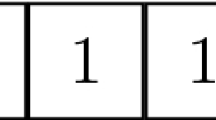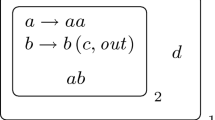Abstract
Watson-Crick L systems are language generating devices making use ofWatson-Crick complementarity, a fundamental concept of DNA computing.These devices are Lindenmayer systems enriched with a trigger forcomplementarity transition: if a ``bad'' string is obtained, then thederivation continues with its complement which is always a ``good''string. Membrane systems or P systems are distributed parallel computingmodels which were abstracted from the structure and the way offunctioning of living cells. In this paper, we first interpret theresults known about the computational completeness of Watson-Crick E0Lsystems in terms of membrane systems, then we introduce a related way ofcontrolling the evolution in P systems, by using the triggers not in theoperational manner (i.e., turning to the complement in a ``bad''configuration), but in a ``Darwinian'' sense: if a ``bad'' configurationis reached, then the system ``dies'', that is, no result is obtained.The triggers (actually, the checkers) are given as finite state multisetautomata. We investigate the computational power of these P systems.Their computational completeness is proved, even for systems withnon-cooperative rules, working in the non-synchronized way, andcontrolled by only two finite state checkers; if the systems work in thesynchronized mode, then one checker for each system suffices to obtainthe computational completeness.
Similar content being viewed by others
Explore related subjects
Discover the latest articles, news and stories from top researchers in related subjects.References
Csima J, Csuhaj-Varjú E and Salomaa A (2003) Power and size of extended Watson-Crick L systems. Theoretical Computer Science 290: 1665–1678
Dassow J and Păun Gh (1989) Regulated Rewriting in Formal Language Theory. Springer-Verlag, Berlin
Mihalache V and Salomaa A (1997) Lindenmayer and DNA: Watson-Crick DOL systems. EATCS Bulletin 62: 160–175
Mihalache V and Salomaa A (2001) Salomaa, Language-theoretic aspects of DNA complementarity. Theoretical Computer Science 250: 163–178
Păun Gh (2000) Computing with membranes. Journal of Computer and System Sciences 61(1): 108–143
Păun Gh (2002) Membrane Computing. An Introduction. Springer-Verlag, Berlin
Păun Gh and Rozenberg G (2002) A guide to membrane computing. Theoretical Computer Science 287: 73–100
Păun GH, Rozenberg G and Salomaa A (1998) DNA Computing. New Computing Paradigms. Springer-Verlag, Berlin, Heidelberg, New York
Rozenberg G and Salomaa A (1980) TheMathematical Theory of L Systems. Academic Press, New York, London
Rozenberg G and Salomaa A (eds) (1997) Handbook of Formal Languages, 3 volumes. Springer-Verlag, Berlin
Salomaa A (1997) Computability paradigms based on DNA complementarity. In: Keränen V (ed) Innovation in Mathematics, Proc. 2nd Intern. Mathematica Symposium, pp. 15–28. Computational Mechanics Publications, Southampton, Boston
Salomaa A (1998) Turing, Watson-Crick and Lindenmayer. Aspects of DNA complementarity. In: Calude C, Casti J and Dinneen M (eds) Unconventional Models of Computation pp. 94–107. Springer-Verlag, Singapore
Salomaa A (1999) Watson-Crick walks and roads on D0L graphs. Acta Cybernetica 14: 179–192
Salomaa A (2002) Uni-transitionalWatson-Crick D0L systems. Theoretical Computer Science 281: 537–553
Salomaa A, Sosík P (2002) Watson-Crick D0L systems: The power of one transition, TUCS report 439, Turku Centre for Computer Science, Turku, 2002; to appear in Theoretical Computer Science.
Sosík P (2001) D0L systems + Watson-Crick complement = Universal computation. Lecture Notes in Computer Science, 2055, pp. 308–320. Springer-Verlag, Berlin
Sosík P (2003) The power of catalysts and priorities in membrane systems. Grammars, 6
Sosík P, Freund R (2003) P systems without priorities are computationally universal. In: Păun Gh, Rozenberg G, Salomaa A and Zandron C (eds) Membrane Computing Lecture Notes in Computer Science, 2597. Springer-Verlag, Berlin
Author information
Authors and Affiliations
Rights and permissions
About this article
Cite this article
Csuhaj-Varjú, E., Martín-Vide, C., Păaun, G. et al. From Watson-Crick L systems to Darwinian P systems. Natural Computing 2, 299–318 (2003). https://doi.org/10.1023/A:1025415914487
Issue Date:
DOI: https://doi.org/10.1023/A:1025415914487




